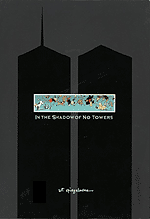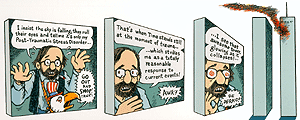
|
Spiegelman's first book, Breakdowns (1977; now out of print), collected early works that used the medium's history to wildly play with the form. One series of strips took a single melodramatic panel of a 50's romance comic and extended the lines past the border, recontextualizing the scene in various, absurd speculations. Comprised of ten broadsheet-size strips by Spiegelman with an addendum of selected turn of the century newspaper strips, In the Shadow of No Towers takes a similar, (co)mixed-up approach. Any one of Spiegelman's pages will use a multiplicity of styles to simultaneously recount his September 11 memories — he lives in downtown New York on the outskirts of Ground Zero — with considerations of the catastrophe's geo-political and personal aftermath.
Spiegelman's slow, agonizing recovery from the day's trauma, made more difficult by a deeply ingrained paranoia and pessimism, becomes the book's emotional and narrative core. Created over the course of two years, he uses the strips to temper, if not actually resolve, his stress. While the early ones recount the agonizing moments of day — hearing the roar of the impact, retrieving his daughter from her nearby middle school, watching as the second tower collapses — the later strips are more abstract. Spiegelman laments what he sees as the co-opting of September 11 to justify further polarizing acts of war. "Why did those provincial American flags have to sprout out of the embers of Ground Zero? Why not a globe," asks the author. Unlike much 9/11-related art, including many comix (see carets above for TIME.comix coverage), No Towers takes exceptional interest in the political consequences of a political act that is often dumbed down to a mere "attack on freedom." It's a strong tonic to the otherwise sentimental tributes. Working through his anger, Spiegelman comes up with searing images like the one where Bush and Cheney ride a giant eagle with a "Let's Roll!" whoop, while slitting its throat with a box cutter.
 The author obsesses on 9/11 in "The Shadow of No Towers"
The author obsesses on 9/11 in "The Shadow of No Towers" |
Two motifs dominate the sophisticated but always readable layouts. The first, naturally, is that of the towers, or more specifically the orange skeleton of the north tower, seen by Spiegelman just seconds before its collapse. The image appears in every episode of "No Towers," but noticeably smaller each time. This ultra-modern, terrifying vision finds its counterpoint in the nostalgia and comfort of the series' other major motif: old newspaper comics. Explaining that these "unpretentious ephemera from the optimistic dawn of the 20th century" were "the only cultural artifacts that could get past my defenses," Spiegelman works them into the strips in new and unexpected ways. Rudolph Dirk's Katzenjammer Kids, two of America's earliest cartoon troublemakers, now appear as the twin towers personified. In another strip Spiegelman depicts himself as Jiggs, the Bringing Up Father prole turned jumpy hubby who now watches too much CNN. The artist mimics the old works expertly, along with a wide variety of other artistic styles that reflect the author's fractured state of mind. In less expert hands the clashing visuals may well have collapsed into unreadable chaos. Here they knit into an edgy cohesion.
The newspaper comic motif also smartly matches the form of No Towers. The German newspaper that originally commissioned the project gave Spiegelman an unheard-of deal in these days of ever-shrinking funnies: an entire full-color page with total editorial freedom. The book nearly replicates their original monumental size on super thick cardstock paper. You read each strip horizontally across two pages but thanks to the clever binding, each strip lies flat, without an annoying gutter in the middle.
Even though the book is physically big and heavy, it reads fast. The ten original strips have been padded out with a fascinating but limited collection of the old strips that Spiegelman found particularly prescient to the events of a century later. One episode of Winsor McCay's Little Nemo in Slumberland has Nemo and his pals as giants, toppling over the buildings of New York. Only 36 pages, the book amounts to little more content than an average comic. Frustratingly, the author's introduction tantalizes us with synopses of strips he didn't get to. Just do them, man! You close the book feeling it lacked development.
Though it may be brief, In the Shadow of No Towers synthesizes Art Spiegelman's incomparable talents for personal history and comix theory into a timely and unique work of art. Using the medium's past to explore new kinds of expression, the book captures the visual experimentation of the old strips and updates them to modern times. What a treat to see Spiegelman back in his element. Let us hope it doesnt take another atrocity to keep him going.
